Peckham originally lay within the medieval parish of St Giles, Camberwell, as also did Nunhead, Dulwich and part of Herne Hill. The first Anglican church to be built within the bounds of modern Peckham was St Chrysostom in 1814. Camden Chapel on the north side of Peckham Road had opened in 1797 as a Protestant Dissenting Chapel, but did not become a parish church until 1844. Extensive house building accompanied the arrival of the railway in Peckham in the 1860s (Peckham Rye station 1865, Queens Road 1866 and Nunhead 1871), and followed in the second half of the nineteenth century. Daughter and mission churches proliferated, carved out of each parish as the congregation exceeded the capacity of the building or the capabilities of its staff. By 1905 there were fourteen parish churches within the area now defined as Peckham (SE15), plus parts of the parishes of a further four. In 1922 there were over 30 ecclesiastical parishes in the former Camberwell.
Since the Second World War, however, a combination of war damage, decay and the cost of maintenance, and falling congregations has resulted in the abandonment and demolition of many premises and the merger of both parishes and congregations.
Peckham has been in the Diocese of Southwark since 1905. From 1877-1905 it was in the Diocese of Rochester and, before then, Winchester.
St Giles
81 Camberwell Church Street, Camberwell, SE5 8RB
Website: stgilescamberwell.org
Church history: St Giles, Camberwell
- Built: Mediæval parish church, rebuilt in 14th century
- . 1842-44 Architect: Scott & Moffatt
- Parish: Current
- The ‘mother’ parish church for Peckham
- Population: 21,924 (1903)

St Giles, Camberwell c. 1825
The parish church of ST GILES is a large building of stone in the style of the 14th century, erected in 1844 and designed by Sir Gilbert Scott after the old church had been burnt down. It has a chancel of three bays, central tower with an octagonal stone spire, transepts, nave of five bays, with a clerestory, low aisles and north and south porches. The roofs are covered with lead. The churchyard is large and contains many graves to the south and west of the church, but none to the north between the church and the road.
Victoria County History, History of the County of Surrey: Volume 4 H.E. Malden (editor), 1912
Camden Church
Peckham Road, Camberwell
- Built: 1796-8, 1814/1854
- Architect: George Gwilt (1796) Gilbert Scott (1854)
- Consecrated: November 1844
- Parish: 1844-????
- Population: 7,942 (1903)
- Church demolished. The building was within the present parish of Camberwell, St Giles with St Matthew.
- The church itself was in what is Camberwell today (SE5).
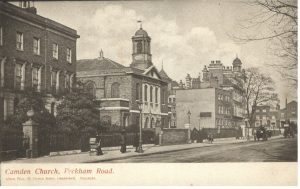
Camden Church, early 20C
The first church opened in 1797 when seceders from St Giles Camberwell who found the doctrines of the new Vicar not altogether to their taste decided to create their own evangelical chapel. The Nonconformist chapel opened under proprietary management in the ‘Countess of Huntingdon’s Connexion’. It became an Anglican chapel of ease in 1829, was eventually consecrated as a parish church in 1844. It was substantially enlarged in 1854
The church . . . is built of stock brick with stone dressings in the Renaissance classic style of the period; it has a chancel and nave with short transepts. The west front towards the road contains the three principal entrances and has a horizontal parapet. Camden chapel, built in 1795, and subsequently enlarged, is a handsome edifice of brick, with a campanile turret.
Victoria County History, History of the County of Surrey: Volume 4 H.E. Malden (editor), 1912
The church hall was destroyed by bombing in 1940 and the church itself badly damaged in 1940 and 1941. However, vestry and crypt were made good and services continued amidst the ruined fabric until 1952. Baptisms and marriages took place there until 1951. The church was closed in spring 1952 and demolished but the parish was not formally abolished until 1961 when it was divided between St Luke and St Giles.
Mission churches and halls
Sumner Road and Melon Ground
St Chrysostom
Peckham Hill St
- Built: 1813-14 Architect unknown
- Consecrated: 1814
- No. of seats: 800 (1894)
- Parish: 1885-1960
- Population: 7419 (1903)
- Church demolished 1963. The building was within the present parish of St John with St Andrew.
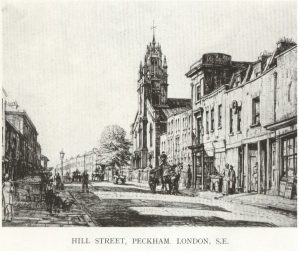
from ‘Studies in Street Architecture’ by Francis Dodds (c. 1914)
St Chrysostom’s church was first known as Peckham Chapel. It was originally a Proprietary Church (41 proprietors owned the £100 shares) and opened for divine service by Bishop’s Licence. As ownership of shares reduced to a handful of people, fund-raising enabled the purchase and formation into a district church. In 1865 it was renamed St Chrysostom after St John Chrysostom, Bishop of Constantinople (347-407). His nickname Chrysostom meant “golden-mouthed”. The parish was not created until 1885.
The church . . . is a barn-like structure of stock brick and cement of the quasi-Gothic of about 1830–40. The chancel and nave are of equal width (the latter having galleries) lighted by wide pointed single lights and having an embattled parapet. The west front, which is of cement, faces the road, contains three entrances and is surmounted by a bell turret with an octagonal lantern.
Victoria County History, History of the County of Surrey: Volume 4 H.E. Malden (editor), 1912
The church survived the war, though with some damage. From 1960-1978 it was part of the united parish of St Chrysostom and St Jude. In 1962 the building was declared unsafe due to dry rot. Services were held in the Peckham Settlement for three years while fund-raising and planning were in progress, but after several failed restoration attempts it was finally decided that the site of the bombed St Jude would be more suitable for a new church, and the church was demolished in 1963.
Mission churches and halls
St Chrysostom’s Hall, Goldsmith Road
St George
Trinity College Centre, Coleman Road, Camberwell, SE15 6EF
Website: http://trinitycollegechapel.com/camberwell/
Church history: Trinity in Camberwell
- Built: 1822–24 Architect: Francis Octavius Bedford Cost: £17,000
- Consecrated: 1824
- No. of seats: 1500 (1894)
- Rebuilt: 1983 Architect: Millard Wrighton & Wynn on new site
- Parish: 1825–current. Most of this is SE5.
- Population: 16,115 (1903)
- Original building converted to flats
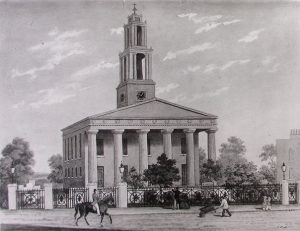
St George’s Church, c. 1850s
In August 1820 the members of Camberwell Vestry agreed that a new church “to hold 2000 persons, one-third to be free sittings” was required in the district to accommodate the growing population. St George’s Church was built in Wells Street among green fields on the south bank of the Surrey Canal.
The church . . . consists of a small apsidal chancel with a large nave at the west of which is a hexastyle Doric portico. Above this is a square tower in three stages, the first of which is solid, whilst the second and third open with Doric and Ionic columns and entablatures. The body of the church and the apse are of stock brick, the portico and tower being of stone. Internally and externally the nave is divided into bays by pilasters of Greek detail. The apse, which is of Roman Doric design, is a much more recent addition. There is a fair-sized churchyard, now used as a small park.
Victoria County History, History of the County of Surrey: Volume 4 H.E. Malden (editor), 1912
The housing around the church was badly bombed during the war and the parish became a building site. The building closed in 1970, and was then gutted by fire and vandalism. It was declared redundant in November 1972 and an order was given for banns and marriages to be held at St Luke. The building was sold to the Celestial Church of Christ in 1976 and later converted to flats. The churchyard was given to the GLC.
In 1982-83 the new church centre was built. Trinity College Centre is part of the Charity ‘Trinity in Camberwell’ which has for the past 120 years been the social outreach of Trinity College Cambridge. It incorporates the present church, and the old church now once more faces green fields – this time of Burgess Park.
Mission churches and halls
Trinity College Mission – Mission from Cambridge College
Christ Church
676, Old Kent Rd, SE15 1JF
Website: www.christchurchpeckham.info
- Built: 1813-14 Architect unknown
- Consecrated: 1814
- No. of seats: 800 (1894)
- Parish: 1885-1960
- Population: 7419 (1903)
- Church demolished 1963.
Christ Church was built on the north side of the Old Kent Road in 1838, but the rapid growth of the adjacent South Metropolitan Gas Works, opened in 1833, forced a move. The new church opened on the opposite side of the road in 1868.
The church was built about 1840 of brick with stone dressings in the style of the end of the 13th century and consists of a chancel, nave, south transept and aisle, and north baptistery and a south-east tower.
Victoria County History, History of the County of Surrey: Volume 4 H.E. Malden (editor), 1912
Though damaged by bombing, it survived the war and is still in use.
Mission churches and halls
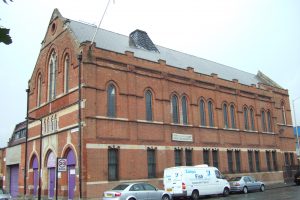
Corpus Christi Mission, Ilderton Road
Corpus Christi College Cambridge Mission, on Road, was built in 1887. After a spell as a photocopier suppliers, it has now been sold to another Christian denomination.
Christ Church Mission, Lower Park Road
St Mary Magdalene
17, St Mary’s Rd, SE15 2EA
Website: www.stmaryspeckham.co.uk
Church history: St Mary Magdalene
- Built: 1839-41 Architect: R P Browne
- Consecrated: 7 May 1841
- No. of seats: 1100 (1894)
- Rebuilt: 1961–62 Architect: Robert Potter
- Consecrated: 3 November 1962
- Parish: 1842-current
- Population: 12789 (1903)
- St Mary’s Church c. 1906
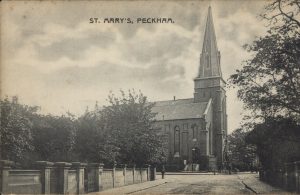
St Mary Magdalene, c. 1906
St Mary’s Church was built on an oval plot of ground formerly called the “Duck’s Nest”. The surrounding fields were market gardens before being taken for house building.
The church . . . was built about 1840 of stock brick in the style of the end of the 12th century. It has a shallow chancel with vestries, &c., a wide nave with galleries and an engaged west tower with an octagonal brick spire and a clock.
Victoria County History, History of the County of Surrey: Volume 4 H.E. Malden (editor), 1912
The church was destroyed by a land-mine on 21 September 1940. The new church, an open-plan cruciform design, was opened in 1962.
Mission churches
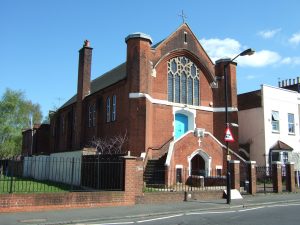
Hooper Hall, Consort Road
St Paul’s Church and Hooper Hall, Consort Road opened in January 1907.
St Mary’s Hall, St Mary’s Road and St Mary Magdalene’s Schools
St John the Evangelist
East Dulwich Road, SE22 9AT
Website: www.stjohnseastdulwich.org
- Built: 1863-65 Architect: Charles Bailey Cost: £8000
- Consecrated: 16 May 1865
- No. of seats: 900 (1865)
- Restored: 1951 Architect J B S Comper
- Parish: 1865-current The church building is in East Dulwich (SE22) but part of the parish is in Peckham.
- Population: 21,926 (1903)
St John’s Church on Goose Green was erected in 1865 to replace the small building known as East Dulwich Chapel (built 1826). The parish was taken out of St Giles.
The church, which stands on Goose Green, is built of rubble and Bath stone in the style of the 13th century. It has a chancel with a round apse and vaulted ceiling, nave with a clerestory lighted by dormer windows, narrow north and south aisles of five bays, porches, &c., and a south-east transeptal tower containing a side chapel with a gallery over, and crowned by an octagonal tiled spire. The roofs are slated.
Victoria County History, History of the County of Surrey: Volume 4 H.E. Malden (editor), 1912
The church was damaged by bombing in 1940 and re-opened after restoration in 1951.
Mission churches and halls
St Andrew’s Mission Church, Waghorn St, was built in 1903 to replace a temporary iron church on the site. It fell out of use in 1932 and was sold in 1948 to fund the restoration. It is now Francis Bacon Lodge.
St Andrew
Glengall Road, SE15 6RH
- Built: 1865 Architect E Bassett Keeling Cost: £6000
- Consecrated: 23 October 1865
- No. of seats: 870 (1894)
- Parish: 1866–1956. The building was within the present parish of St John with St Andrew.
- Population: 7,384 (1903)
- Church building sold to another Christian denomination.
St Andrew’s church was erected mainly through the efforts of the then incumbent of Camden Chapel and other local residents. The parish was taken from Camden Chapel and Christ Church. The church was built on the site of a former apple orchard and consecrated in October 1865. St Andrew’s Hall opened in the 1890s.
The church consists of a chancel, nave, narthex and tower. It is built of stone and is designed in the style of the late 13th century. The tower is surmounted by a shingled spire.
Victoria County History, History of the County of Surrey: Volume 4 H.E. Malden (editor), 1912
It was severely damaged in the 1940-1 blitz. Services were held in the church hall post-war, and the church re-opened after restoration in 1954. In 1956 the parish was united with All Saints, North Peckham. By 1978 the church was isolated in the middle of a vast building site and, recognising that the parish was no longer independently viable, the church was declared redundant in March 1978 and the parish united with St John, Peckham. The church was sold to the Celestial Church of Christ.
Mission churches and halls
St Andrew’s Church Hall is opposite
St Jude
Springhall Street/Meeting House Lane
- Built: 1865 temporary church
- 1875-6 Architect: Blomfield Cost: £700 (the temporary church)
- Consecrated: 1879
- No. of seats: 800 (1894)
- Parish: 1880-1960
- Population: 9,860 (1903)
- Church demolished. The building was within the present parish of St John with St Andrew
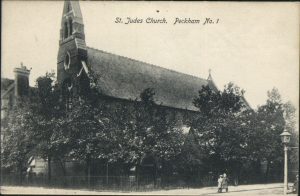
St Jude’s Church, c. 1905
A temporary iron church was built in Asylum Road in 1865 to evangelise the gangs of railway workers building Queen’s Road station. In 1879 the new church of St Jude was completed in Meeting House Lane.
The church is built of stock and red brick and stone in the style of the 12th century. It has a chancel with organ chamber, south chapel, nave with a clerestory, aisles with arcades of four round-arched bays and north-west and south-west porches; a bell-cote above the west gable contains two bells. The aisle windows have semi-dormer gable heads. The roofs are covered with slates. The chancel arch is spanned by a carved oak screen, above which is a rood with figures.
Victoria County History, History of the County of Surrey: Volume 4 H.E. Malden (editor), 1912
The church was bombed in October 1940; thereafter marriages were solemnized at St Chrysostom’s Church, Hill Street, or in St Jude’s church hall. St Jude’s parish was united with that of St Chrysostom, as St Chrysostom and St Jude, in 1960, and St Chrysostom’s church became the parish church of the united parish.
Mission churches and halls
St Jude’s Parochial Hall, Meeting House Lane
All Saints, Blenheim Grove
Blenheim Grove, SE15 4QS
Website: http://allsaintspeckham.org.uk
- Built: 1870-72 Architect: H E Coe Cost: £6,480 (church and school)
- Consecrated: 24 July 1872
- No. of seats: 800 (1894)
- Parish: 1872-current
- Population: 5,289 (1903)
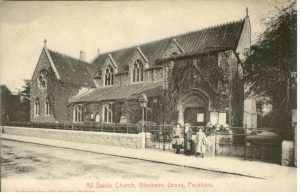
All Saints Church c.1905
The school-church was opened in 1866. The foundation-stone of the present church was laid in 1870, and the new building consecrated in July 1872. All Saint’s Church is in the centre of Peckham, right next to the ‘new’ Peckham Rye station which had opened only seven years earlier.
The church was built about 1870 of rag and Bath stone in the style of the 13th century. It consists of a chancel with a round apse, nave with semi-dormer clerestory windows, vestries, &c., north and south aisles and the stump of a north-west porch tower with one bell. The roofs are tiled.
Victoria County History, History of the County of Surrey: Volume 4 H.E. Malden (editor), 1912
Both parish and church survived the war, and are still in use.
Mission churches and halls
All Saints, Victoria Place, High Street
St Antholin
Nunhead Lane, SE15 3TU
- Built: 1878 Architect: Ewan Christian
- Consecrated: 11 May 1878
- No. of seats: 1000 (1894)
- Restored: 1957 Architect: Lawrence King
- Consecrated: 12 October 1957 (as “St Antony”)
- Parish: 1878-2001 United to become St Antony with St Silas, Nunhead
- Population: 19,126 (1903)
- Church building sold to another Christian denomination (Lighthouse Cathedral)
Nunhead, previously part of the parish of St Mary Magdalene, was designated a Mission District with a priest-in-charge in 1865. A room on Nunhead Green was used until the temporary corrugated iron church of St Michael was built in Linden Grove. It achieved the status of a separate parish in 1878, and the new church was built 1877-8 using the proceeds from the sale of St Antholin’s Church, Watling St.
The church is a large rectangular structure of red brick, built in 1877, in the style of the first part of the 13th century. It has a nave and chancel of equal width, the nave having a clerestory with lancet windows, north and south aisles, transepts, porches, &c. The middle roof is gabled and covered with slates, the aisles have lean-to roofs. The oak reredos designed by Sir Christopher Wren and a bell were brought from St Antholin’s, Watling Street.
Victoria County History, History of the County of Surrey: Volume 4 H.E. Malden (editor), 1912
The interior was restored in 1912 and 1938, only to be gutted by firebombs in 1943. The final restoration was completed in 1957 and the church re-dedicated to “St Anthony”. In February 2001 it was declared redundant, and has since been sold.
Mission churches and halls
St Michael, Nunhead (see above)
St Luke
Pentridge Street/Chandler Way, North Peckham SE15 6ED
Website: http://stlukespeckham.co.uk
- Built: 1873-74
- . 1876-77 Architect: J E K Cutts
- Consecrated: 13 October 1877
- No. of seats: 700 (1894)
- Rebuilt: 1953-4 Architects: A C Martin; and Milner & Graze
- Parish: 1878 – current
- Population: 10,214 (1903)
During the 1860-70s the Rosemary Branch estate was built on the fields of North Peckham and the Rosemary Branch Pleasure Gardens. A temporary church, a daughter church in the parish of St George, was built in 1874 to serve the new congregation. It held only 250, however, and was soon obviously too small. The new St Luke’s Church opened in 1877.
The church, which is situated in Rosemary Road, consists of a chancel and nave with aisles in one range and a south-west porch. It is of the simplest design and is built of stock bricks.
Victoria County History, History of the County of Surrey: Volume 4 H.E. Malden (editor), 1912
The church was destroyed by bombing in the Second World War. It was rebuilt in brick “neo-Byzantine” style in 1953.
St Saviour (Copleston Centre)
Copleston Centre, Copleston Road, SE15 4AN
Website: www.coplestoncentre.org.uk
- Built: 1880-81 Architect: Weekes & Hughes
- Consecrated: 22 February 1881
- No. of seats: 850 (1894)
- Remodelled: 1978-79 by Thomas Ford & Partners
- Parish: 1881-current
- Population: 5147 (1903)
St Saviour’s Church was built in 1881, with the parish taken out of St John’s, East Dulwich.
The church . . . was built about 1880 of white bricks with stone dressings in the style of the 14th century. It consists of a chancel, nave with a clerestory lighted by dormer windows, low aisles of six bays with round pillars and pointed arches, north organ chamber and a south chapel. The entrance to the chancel has an oak screen and rood.
Victoria County History, History of the County of Surrey: Volume 4 H.E. Malden (editor), 1912
In the late 1970s, the congregation of St Saviour’s and Hanover United Reformed Church, Peckham, jointly planned the remodelling of the building which was redeveloped as a community centre. The Copleston Centre Church, a Local Ecumenical Partnership, was created in 1981.
Mission churches and halls
St Saviour’s Mission, Choumert Road
St Mark
Harders Road
- Built: 1884-5 Architect unknown
- Consecrated: 25 March 1884
- No. of seats: 804 (1894)
- Parish: 1884-1960
- Population: 8,530 (1903)
- Church demolished 1959. The building was within the present parish of St Mary, Magdalene.
St Mark’s Church began as a mission church for St Mary Magdalene, and the first services were held in St Mary’s National Schools. A permanent church was consecrated in 1885, with the parish taken out of St Mary’s.
The church . . . is a building of red brick and stone in the style of the 13th century erected in 1883; it has a continuous chancel and nave, the former having an arch on either side opening into an organ chamber and a vestry, nave and low aisles, with arcades of three wide bays; a bell hangs in a bell-cote above the west gable.
Victoria County History, History of the County of Surrey: Volume 4 H.E. Malden (editor), 1912
In 1944 the church was badly damaged by a flying bomb. It was demolished in 1959 and the parish transferred to St Chrysostom and St Jude the following year.
All Saints, North Peckham (“The Moving Church”)
Davey St, off Sumner Road
- Built: 1893-94 Architect Walter Planck
- Consecrated: 1894
- No. of seats: 800 (1894)
- Parish: 1892–1956
- Population: 5049 (1903)
- Church demolished and rebuilt in Biggin Hill. The building was within the present parish of St John with St Andrew
The parish was created in 1892 from part of the parishes of St George Camberwell, St Luke Peckham and Camden Chapel. The foundation stone of All Saint’s Church was laid on 1 November 1894.
The church consists of a chancel with north organ chamber and vestry and south chapel, a nave with north and south aisles, a north porch and a west baptistery. The whole church is well and freely designed in late 13th-century style, and is built of red brick and stone with tile roofs.
Victoria County History, History of the County of Surrey: Volume 4 H.E. Malden (editor), 1912
The church was undamaged by war but abandoned by its clergy and its functions were taken over by the Vicar of St Andrew. It became derelict, and in 1956 the parish was united with St Andrew.
In 1952, however, the post-war shortage of building materials did not deter the Vicar of St Mark’s, Biggin Hill, Kent, who wanted to replace his temporary church in this growing suburb with a more permanent structure. He gained permission to dismantle All Saints and moved 125,000 bricks and also stone and timber to Biggin Hill. “The moving church” was consecrated 25 April 1959 – see St Mark’s website: www.movingchurch.org
Mission churches and halls
All Saints Parochial Hall, Sumner Road
St Silas (now St Antony With St Silas)
Ivydale Road, Nunhead, SE15 3DF
Website: www.parishofnunhead.org.uk
Church history: St Anthony with St Silas
- Built: 1902-13 Architect: J E K & J P Cutts
- Consecrated: 17 October 1903
- Rebuilt: 2003 Architect: Oliver West & John Scott
- Consecrated: 26 April 2003
- Parish: 1904-current
St Silas’ Church was constructed in 1902-13 following the expansion of housing in south Nunhead at the end of the nineteenth century. Like St Mary Magdalene it was also on a ‘island’ site.
The church was declared redundant in February 2001 and was demolished as it suffered from severe subsidence. A new church of Nunhead, St Antony with St Silas was completed on the same site in 2003. The consecration service for the new church was held on Saturday 26th April 2003 – a century after the first.
Mission churches and halls
Cheltenham College Mission, Nunhead Grove, SE15
St John with St Andrew
10a, Meeting House Lane, SE15 2UN
Website: www.facebook.com/sjc.peckham
- Built: : 1965–66 Architect: David Bush
- Consecrated: 11 June 1966
- Parish: 1960–current
The Church and Parish Centre of St John, Peckham, replaced the demolished and bombed buildings of St Chrysostom and St Jude, two Parishes amalgamated after the war, and was built on the site of St Jude’s. It also includes most of the former parishes of All Saints, Davey Street and St Andrew. It was dedicated to St John Chrysostom and is a modern, open-plan design. It therefore encompasses most of the parishes of five ‘lost’ churches: St Andrew, All Saints North Peckham, St Chrysostom, St Jude and St Mark.
Churches outside Peckham
In addition to St Giles and St John’s, East Dulwich the parishes of the following churches located outside Peckham previously included parts of Peckham:
St Mark, 99-101 Cobourg Road, SE5 0HU: Built 1879-80, parish taken out of St.George & Newington All Saints. Church declared redundant and in 1965 parish united with St Philip & St Mark, Avondale Square. Church sold and New Peckham Mosque was established in 1982 by Sheikh Nazim Kibrisi.
All Saints, Hatcham Park, New Cross Road, SE14: Built 1869-71.
St Augustine, Honor Oak Park, SE23: Built: 1872 – 73, Architect: William Oakley.
The Peckham Parishes
St Giles, Camberwell, was the original mother-church. During the nineteenth century daughter parishes were carved out; by the end of the twentieth they were being merged.
A. Growth
- 1825 St George Created from St Giles
- 1842 St Mary Magdalene Created from St Giles
- 1845 Camden Church Created from St Giles
- 1845 Christ Church Created from St Giles
- 1865 St John, East Dulwich Created from St Giles
- 1866 St Andrew Created from Camden Chapel & Christ Church
- 1872 All Saints Blenheim Grove Created from S.Giles
- 1874 St Luke Created from St. George & St.Giles
- 1878 St Antholin Created from Peckham St.Mary Magdalene
- 1880 St Jude Created from Peckham St.Andrew and Christ Church
- 1881 St Saviour Created from St John, East Dulwich
- 1884 St Mark Created from St Mary Magdalene
- 1885 St Chrysostom Created from St.Giles, Peckham St.Andrew and Peckham St.Mary Magdalene
- 1892 All Saints, North Peckham Created from St.George, Camberwell St.Luke, Camden Chapel
- 1904 St Silas Created from St Augustine, Honor Oak Park
B. Amalgamation
- 1956 St Andrew With All Saints Union of St Andrew and All Saints, North Peckham
- 1957 St. Antholin Dedication changed to St. Antony, Nunhead
- 1960 St Mark Abolished; part to create St Chrysostom & St Jude, part to St Mary Magdalene.
- 1960 St Jude Abolished; part to create St Chrysostom & St Jude, part to All Saints Hatcham Park
- 1960 St Chrysostom Abolished; part to create St Chrysostom & St Jude, part to St Mary Magdalene, part to St Luke
- 1960 St Chrysostom & St Jude Created By union: part of: St Andrew with All Saints, St Chrysostom, St Jude, St Mark.
- 1961 Camden Chapel Abolished; part to St Luke, part to St Giles
- 1966 St John, Peckham Renaming of St Chrysostom & St Jude
- 1977 St John with St Andrew Union of St John, Peckham and St Andrew With All Saints
- 1978 St Chrysostom & St Jude Abolished
- 2001 St Antony with St Silas Union of St Antony and St Silas
Further Information
Peckham and Nunhead Churches by John D. Beasley. South Riding Press (1995)
Ye Parish of Camerwell W. H. Blanch. (1875)
Victorian Suburb: A Study of the Growth of Camberwell. H.J. Dyos (1961)
Family History in Southwark and Guide to Tracing your Southwark Ancestors Leonard Reilly. London Borough of Southwark (1996)
Guide to the Archives in Southwark Local Studies Library Stephen Humphrey. London Borough of Southwark (1992).
Ordnance Survey maps
The Godfrey Edition reprints £2.20 each http://www.alangodfreymaps.co.uk/
Peckham (1872, 1894, 1914), Peckham (S and SW) and East Dulwich (1868, 1894, 1914)
The perimeter of Peckham also features on the on the following:
E: New Cross & Deptford Broadway (1871, 1894, 1914); N: Old Kent Road (1871; 1894; 1914); Deptford North (1914)
W: Camberwell and Stockwell (1871, 1913), SW: Brockley & Honor Oak (1868, 1894, 1914),
Southwark Diocesan record office: www.southwark.anglican.org/parishes/records.htm
Current parishes: http://www.southwark.anglican.org/where/
‘Lost’ churches: http://www.southwark.anglican.org/where/lost-churches
Southwark Local History Library: http://www.southwark.gov.uk/DiscoverSouthwark/heritageandhistory/LocalHistoryLibrary/
London Metropolitan Archives www.cityoflondon.gov.uk/lma (hold many original Parish registers)
[Text moved from: http://www.peckhamhistory.org.uk/churchesCofE.htm]


